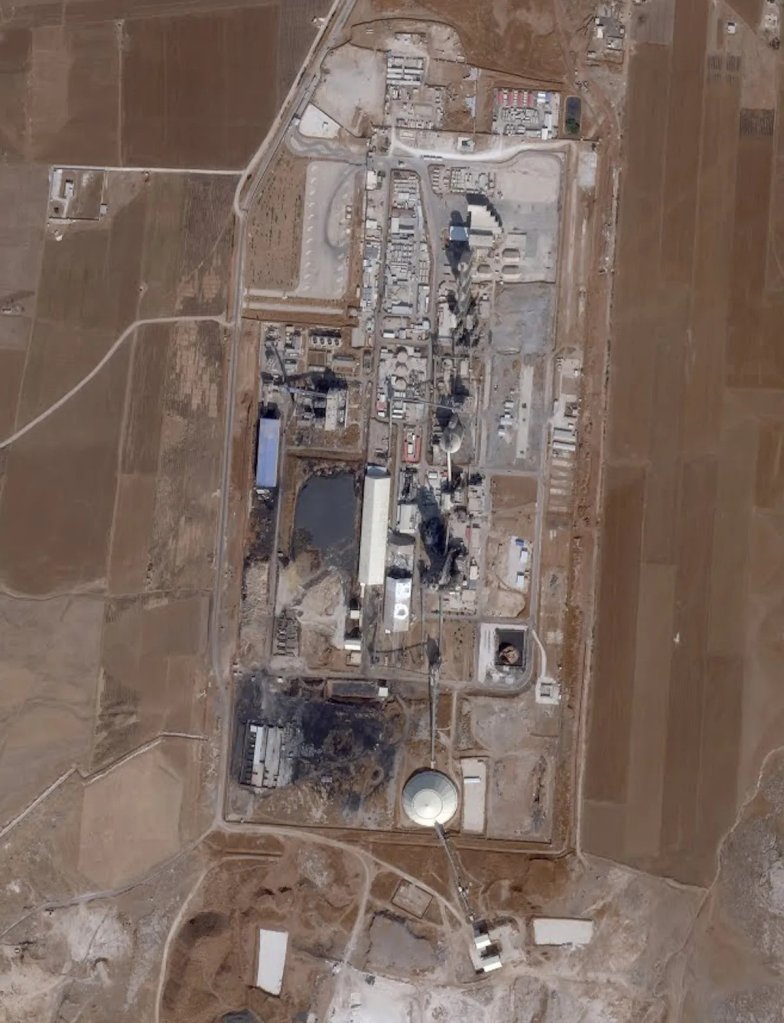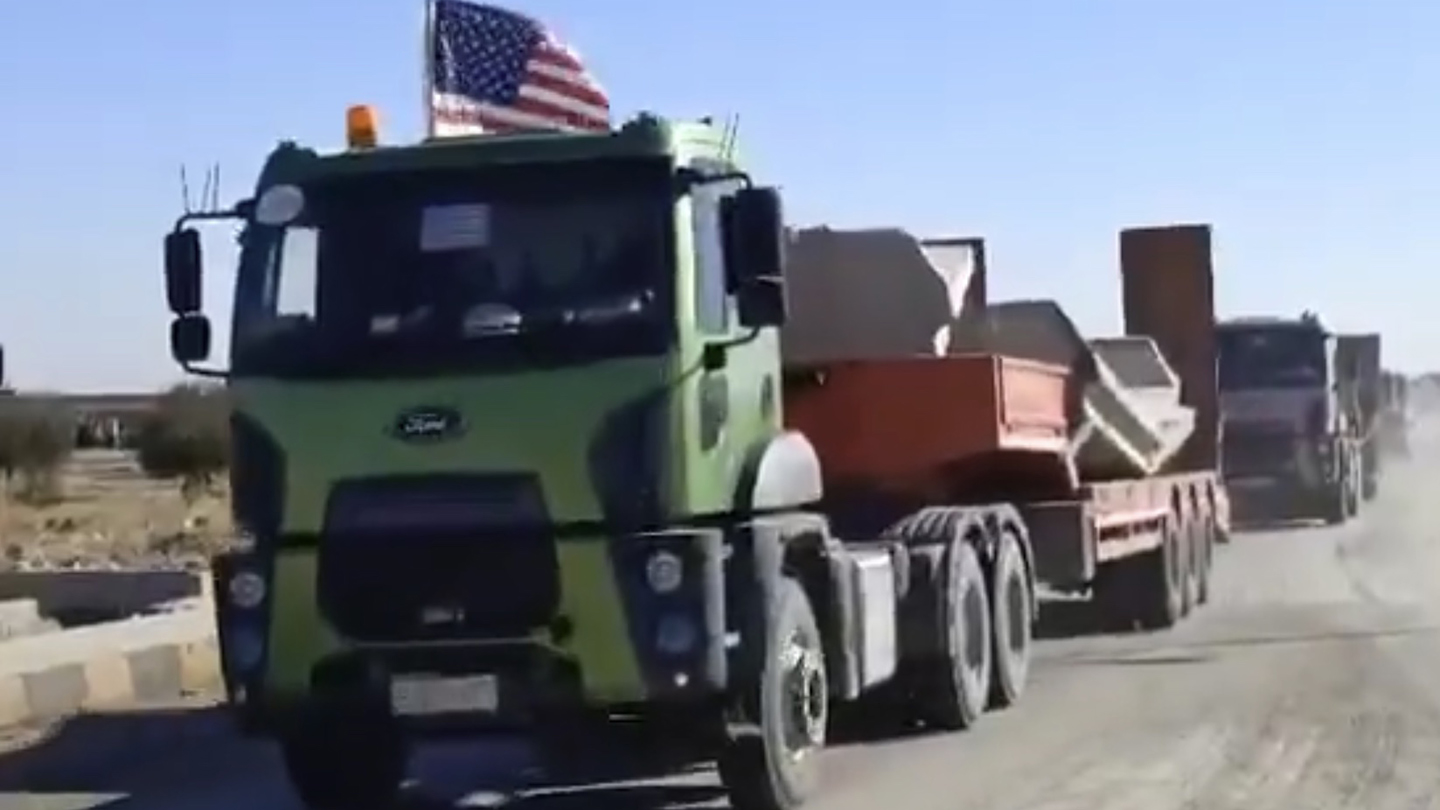A half dozen years after abandoning Kobani, U.S. forces are reportedly building a base in this northern Syrian city on the Turkish border that has been riven by strife between Kurdish-led Syrian Democratic Forces (SDF) and Turkish-backed forces. This all comes as a new Syrian government is trying to establish control over the country after ousting Bashar al-Assad.
Several videos and images have emerged on social media claiming to show U.S. troops and equipment heading toward Kobani, reportedly to build a new international coalition base. The U.S. has a presence of about 2,000 troops in Syria, ostensibly deployed to continue the ongoing fight against ISIS. That fight apparently came to the U.S. on Wednesday, when a man claiming ISIS affiliation carried out a deadly attack in New Orleans.
U.S. forces “brought in a convoy of 50 trucks carrying cement blocks to SDF-controlled areas in north-eastern Syria,” the London-based Syrian Observatory for Human Rights (SOHR) wrote Thursday morning. “SOHR activists have reported seeing the convoy on Al-Hasakah-Al-Raqqah highway, while it was heading to Ain Al-Arab area (Kobani) in the eastern countryside of Aleppo. The convoy was accompanied by a military vehicle of SDF. According to SOHR sources, this comes as a part of US forces’ efforts to boost their bases and establish a new military base in Ain Al-Arab in light of the growing security and military tension in that region.”
The international coalition forces “brought a convoy of logistic reinforcements including premade chambers, surveillance cameras, cement blocks, fuel tanks and digging machinery towards Kobani,” SOHR added. “…the digging and drilling will start tomorrow and more military reinforcements such as soldiers, weapons, armored vehicles, radars, and anti-aircraft weapons will be brought.”

This assessment was shared by the pro-SDF North Press media outlet.
“The U.S.-led Global Coalition began on Thursday establishing a military base in the city of Kobani, northern Syria,” the publication reported. “North Press correspondent documented trucks transporting concrete blocks to Kobani for the base’s construction.”
The convoy “included logistical supplies such as prefabricated rooms, surveillance cameras, trench-digging equipment, concrete blocks, and fuel tanks,” North Press added. “A hotel has been designated as the central site for the Coalition’s base in the city center of Kobani.”
The War Zone cannot independently verify these claims and has reached out to U.S. Central Command and the White House National Security Council for details. We will update this story with any information provided.
After pulling out of the Kobani area, the U.S. military announced that a pair of U.S. Air Force F-15E Strike Eagles had struck the defunct Lafarge Cement Factory in northern Syria, on Oct. 16, 2019. This facility sits along the highly strategic M4 highway between the cities of Ain Issa and Kobani, and had served as the “headquarters of the de facto Defeat-ISIS coalition in Syria,” U.S. Army Col. Myles Caggins, chief spokesperson for the U.S.-led coalition fighting ISIS in Syria and Iraq, said on Oct. 15, 2019. The base was used extensively to support special operations and included landing pads for multiple helicopters. It is unclear if this is the facility the U.S. is reportedly trying to build up now.
After the U.S. departed the facility, Russian forces took it over and remained there until pulling most of its troops out of Syria in the wake of the Assad ouster.
You can see that site in a satellite image obtained by The War Zone at the time.

At the core of the issue is Turkey’s long-standing contention that SDF is functionally indistinguishable from the Kurdistan Workers’ Party, or PKK. Both the United States and Turkey have designated the PKK, which has operated in Turkey, northern Syria, and northern Iraq, as a terrorist group. However, the U.S. government insists that PKK and SDF are separate organizations.
The claimed U.S. build-up in Kobani comes as fighting continues between the SDF and Turkish-backed forces in northern Syria.
Video emerged on social media claiming the SDF downed a Turkish Bayraktar TB-2 drone over the Qarqozak Bridge, south of Kobani. It is claimed to be the third such shootdown in a month.
Turkish-backed forces have reportedly escalated attacks on the Tishreen Dam as well as the Qara Quzak Bridge, both key to logistics in the area. Kurdish journalist Rohat Baran emphasized that these sites are not just vital for the local population but also hold broader regional importance in terms of trade, energy, and military operations.
The Qara Quzak Bridge is a pivotal location along the M4 international trade route, a corridor connecting key areas such as Kobani, Raqqa and Manbij, Baran noted.
“This route is essential for logistics, commerce, and defense in northern Syria,” he reported. “The Tishreen Dam, meanwhile, supplies electricity to vast parts of northern Syria, including Aleppo, Deir ez-Zor, and al-Hasakah. Losing control of these sites could have catastrophic consequences for the region’s infrastructure and security.”
“The defense of Tishreen and Qara Quzaq is not merely local but encompasses the security of Kobani, Raqqa, and the broader…region,” Baran continued.
Fighting between SDF and Turkish-backed forces also continues near the town of Manbij, about 30 miles southwest of Kobani. Just before Christmas, SDF announced a counteroffensive against the Turkish-backed Syrian National Army near Manbij.
As SDF and the Turkish-backed rebels duke it out in the north, the U.S. and allies continue to bombard ISIS strongholds in central and eastern Syria.
“Our armies remain engaged in the fight against terrorism in the Levant,” French Defense Minister Sebastien Lecornu wrote on Twitter Tuesday. “They have contributed to the international coalition ‘Operation Inherent Resolve’ (OIR), since 2014 in Iraq and 2015 in Syria. On Sunday, French air assets carried out targeted strikes against Daesh sites on Syrian soil.”
The defense ministry told Agence France-Presse (AFP) that France’s Rafale fighter jets and US-made Reaper drones “dropped a total of seven bombs on two military targets belonging to Daesh in central Syria,” the French Le Monde news outlet reported. It was the first such strike on the country’s soil since the fall of Assad.
On Dec. 23, U.S. Central Command (CENTCOM) forces conducted a precision airstrike on ISIS in the Deir Ezzor Province of central Syria, “killing two ISIS operatives and wounding one,” the command said on Twitter. “The terrorists were moving a truckload of weapons which were destroyed during the strike. This strike occurred in an area formerly controlled by the Syrian regime and Russians. This airstrike is part of CENTCOM’s ongoing commitment, along with partners in the region, to disrupt and degrade efforts by terrorists to plan, organize, and conduct attacks against civilians and military personnel from the U.S., our allies, and our partners throughout the region and beyond.”
The Pentagon continues to maintain that its support for SDF is part of the ongoing fight against ISIS and that it is working with Turkey to stabilize the area.
“…we have been conducting various strikes against ISIS leaders, but in terms of our partnership with SDF, nothing has changed there,” Deputy Pentagon Press Secretary Sabrina Singh told reporters on Monday.
Secretary of Defense Lloyd J. Austin III spoke by phone on Dec. 24 with Turkish Minister of National Defense Yaşar Güler “to discuss the ongoing situation in Syria,” the Pentagon said in a statement. “Secretary Austin emphasized that close and continuous coordination is crucial to maintaining the ongoing success of the D-ISIS mission. The Secretary and Minister Güler also discussed the importance of setting the conditions to enable a more secure and stable Syria.”
Meanwhile, Syria’s new leadership is working to solidify its hold on the country since overthrowing Assad nearly a month ago and says it wants to include SDF in that effort.
The head of Hayat Tahrir al-Sham (HTS), the former al-Qaida-linked group that staged the coup against Assad and now runs the country, met with the SDF on Tuesday for the first time since the overthrow. The results of the discussions between SDF and Ahmed al-Sharaa, now the de-facto leader of Syria, were “positive,” the BBC noted.
Al-Sharaa, also known as Abu Mohammed al-Jolani, confirmed that the transitional administration is in talks with the SDF to resolve the crisis in northeastern Syria, with the aim of eventually integrating the SDF into the national armed forces, the Al Arabiya news outlet reported. He reaffirmed that Kurds are an integral part of Syria’s fabric, ruling out any plans for partition.
“There will be no division of Syria in any way,” al-Sharaa told the publication in an interview. “Negotiations are ongoing with the SDF to resolve the crisis in northeastern Syria,” al-Sharaa explained, adding that the new government would not allow Syria to become a launching pad for PKK attacks.
If the U.S. is indeed establishing a new base in Kobani, it comes as the Biden administration is winding down. If the past is prologue, this may be a short-lived move after Donald Trump takes office on Jan. 20. As we reported at the time, Trump shocked SDF by announcing a withdrawal of U.S. forces from Kobani in 2019. Trump had already stated his intention to eventually pull out all U.S. forces from Syria in December 2018. Despite Trump’s wishes, the U.S. kept troops in Syria throughout his first administration.
In 2021, White House Coordinator for the Middle East and North Africa Brett McGurk noted in the following tweet that Russian troops took over the Kobani facility after the U.S. withdrawal.
As the anti-Assad rebels were advancing across Syria, Trump offered some insight into how he might approach the presence of U.S. troops there in his new administration.
“Syria is a mess, but is not our friend, & THE UNITED STATES SHOULD HAVE NOTHING TO DO WITH IT. THIS IS NOT OUR FIGHT,” he exclaimed. “LET IT PLAY OUT. DO NOT GET INVOLVED!”
As for the potentially ISIS-related attack in New Orleans, a truck driven by Army veteran Shamsud-Din Jabbar allegedly drove into a crowd, killing at least 15 people. Investigators later found an ISIS flag in that truck.
During a press briefing on Thursday, Deputy Assistant Director of the FBI’s Counterintelligence Division Christopher Raia said Jabbar stated in a post on Facebook that he had joined ISIS last summer, CBS News reported. Shortly before the attack, “He posted several videos to an online platform proclaiming his support for ISIS,” Raia said. He added that at this point, there was no definitive link between the New Orleans attack and the detonation of a Tesla Cybertruck full of fireworks and other explosive material outside Trump Hotel in Las Vegas hours later, an event that is being considered a possible act of terrorism.
There is no way to know at the moment how this attack will affect Trump’s calculus on how many troops should remain in Syria, where they will deploy, or if he will keep the new base in Kobani, if indeed it is established. Regardless, America’s battle against ISIS continues.
Contact the author: howard@thewarzone.com
